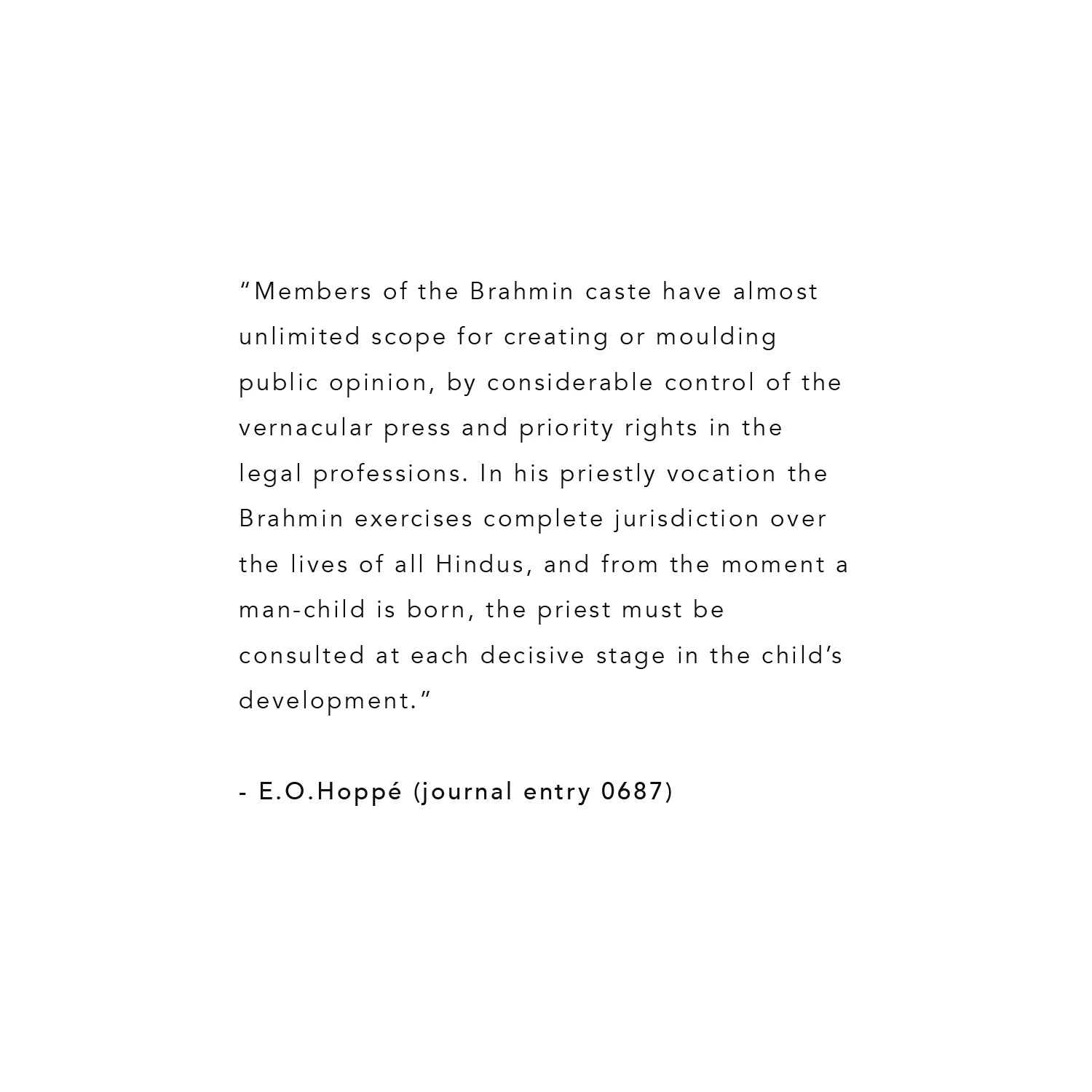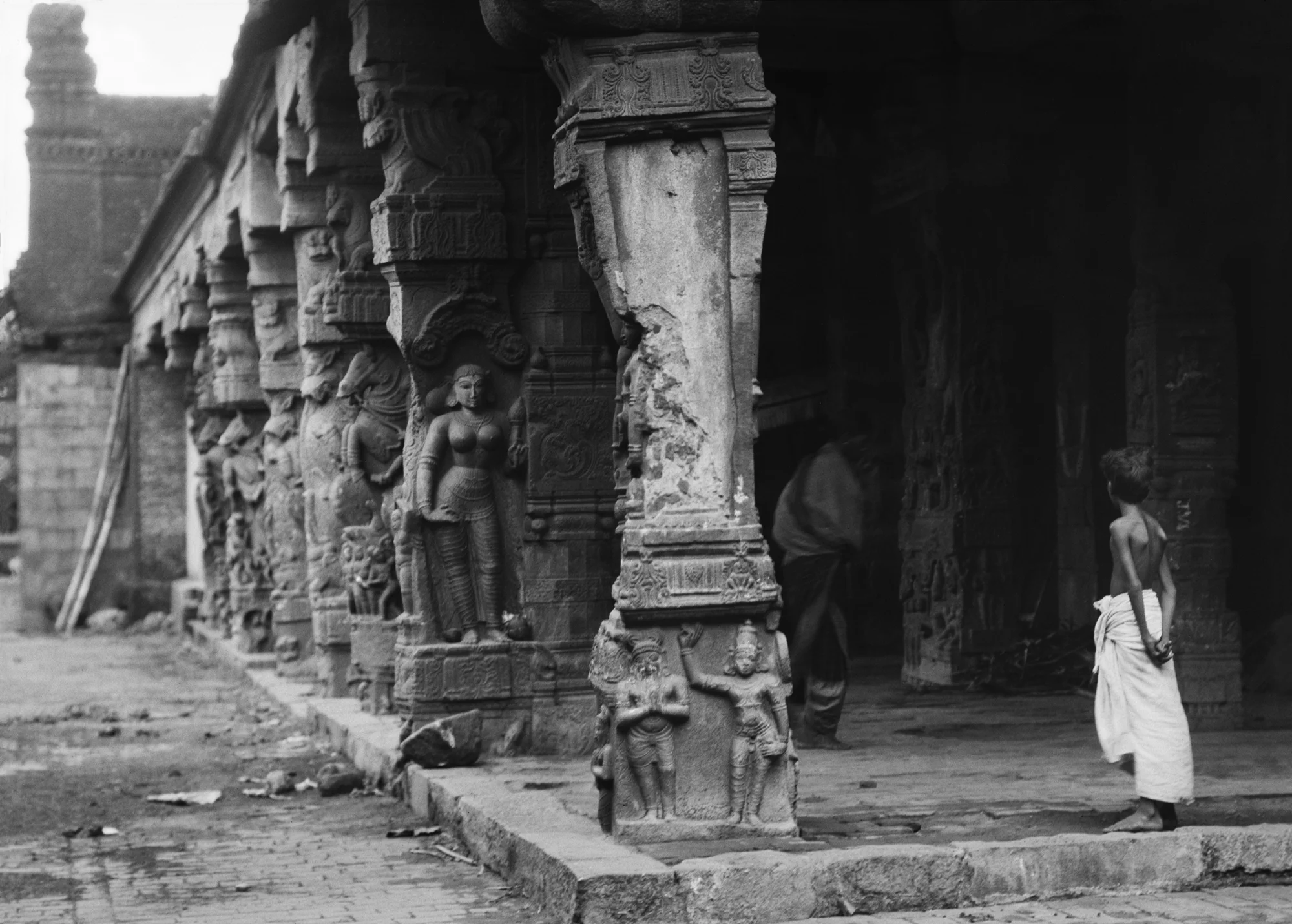A GLANCE INTO THE PAST
FACING THE FUTURE
THE INDIAN SUBCONTINENT COLLECTION
Emil Otto Hoppé (1878–1972) was one of the most important art and documentary photographers of the modern era, whose artistic success rivaled those of his peers Alfred Stieglitz, Edward Steichen, Paul Strand, Walker Evans, and Edward Weston. A Photo-Modernist actively leading the global art scene from 1907 until World War II in London, New York and Berlin, Hoppé chronicled the great variety of multi-cultural peoples in London and later traveled throughout the world photographing people in their countries of origin. In 1945 Cecil Beaton declared Hoppé “The Master” and in 1983 British photo-historian, Bill Jay, dubbed Hoppé, “the most famous photographer in the world in the 1920’s.”
In 1929, over a four-month period Hoppé toured the expanse of the Indian Subcontinent to make a series of photographs that resulted in some 1,371 vintage exhibition-quality photographs and 1,271 vintage contact prints, depicting the diverse peoples and cultures across the Indian subcontinent. Photographed by one of the most socially sensitive visual poets of the era this rich collection of work stands alone as the most important and comprehensive modernist photo-document of the Indian subcontinent in the twentieth century.
Hoppé’s portrayal of the land and its diverse peoples shows us the richness of everyday life in this uniquely compelling region, captured at a pivotal moment in history. Leading Indian art scholar, Dr. Pratapaditya Pal, declared that “No other collection of photography of British India in the twilight of the empire portrays the country with such journalistic precision and Modernist vision as the Hoppé work.”
After being entombed in a London picture library for over sixty years this national treasure was rescued and has now been thoroughly cataloged, digitized and researched to enable it's access to a wider audience in anticipation of its publication and exhibition.
With the collection now poised for its public debut it’s value and legacy will be recognized as the Mahabharata of the modern era documenting the transition of the Indian subcontinent from an agrarian culture to an industrial nation.
CONTACT:
GRAHAM HOWE, DIRECTOR
E.O. HOPPÉ ESTATE COLLECTION
GRAHAM@EOHOPPE.COM
T: +1 626 524 4702
“The only true voyage of discovery, the only fountain of Eternal Youth, would be not to visit strange lands but to possess other eyes, to behold the universe through the eyes of another, of a hundred others, to behold the hundred universes that each of them beholds, that each of them is; and this we can contrive [with great artists]; with men like these we do really fly from star to star.”
MARCEL PROUST, “IN SEARCH OF LOST TIME”
INTRODUCTION
It was early September 1929 and Emil Otto Hoppé – one of the most important art and documentary photographers of the modern era – landed in Colombo, Sri Lanka. Here Hoppé started his first trip through an Indian subcontinent which was being gradually swept by modernity under the British imperial rule. Through both his lens and his writings he immersed himself in the atmosphere of colonial India, becoming a spectator in the exact moment in time where an ancient civilization was colliding with the advances of a new age.
DIVERSITY
Hoppé was fascinated with the remarkable diversity of ethnicities - Hindus, Muslims, the Jewish community, and tribal native groups, among others - and their co-existence within the territory of one country. Hoppé exposed the multifaceted nature of a society of various types, their spiritual devotion and deep-rooted traditions.
PHYSIOGNOMY
As a portrait photographer, Hoppé had a particular interest in physiognomy, believing that life experiences and living conditions shape the way one looks. In India he found a great diversity of the ethnographic types. His sensitivity and empathy allowed him to capture the essence of human nature with a striking depth and emotion.
“How brightly he does it, how penetrating, how his eye pierces the world.”
PETER PANTER
CASTE SYSTEM
Introduced as the basis of order and regularity of society - the caste system divides society into various social layers. From the moment of birth, one is circumscribed by the caste with no ladder to improve their social status. Hoppé believed progress was held back by these subdivisions, and by the inherited prejudices and the lack of ambition that especially plagued the lower classes.
RELIGION
Hoppé was fascinated not only by the diversity of India’s ethnic groups but also by the variety of religions, ancient cults and ceremonies that were an intricate part of society and daily life. He was amazed by the spirituality, religious devotion and rigorous following of rituals in India - some of which were alien and shocking to standard European sensibilities.
SURVIVING MARKS OF HISTORY
Throughout his travels Hoppé captured the poetic images of the ancient religious monuments, royal palaces and courts. While depicting the everyday life of ordinary people and traditions, Hoppe was able to find sublime in the prosaic. His photographs reveal the symbolism and richness of India’s history.
“Hoppé’s pictures were entirely different from the other photographs of that period, for they were imbued with a controlled and subtle romanticism and atmosphere glow – they were the work of someone with taste, perception, appreciation: of someone who used the camera as an artist.”
CECIL BEATON
"The past is not dead, it is living in us, and will be alive in the future which we are now helping to make."
WILLIAM MORRIS
WHEN TRADITION MEETS MODERNITY
Colonialism brought the rapid growth of infrastructure and the influence of western culture into the Indian subcontinent. The atmosphere of ancient splendour was becoming marked by modernity, and Hoppé was there to capture the early traces of this new era.
CAN THE NEW BE ADAPTED WITHOUT DESTROYING THE OLD?
Hoppé believed in technology as an enabler of human life in harmony with nature. He visited various educational centers in India, including Visva-Bharati - Rabindranath Tagore’s university at Santiniketan - modeled after the old ashram system of ancient India and open to the progressive ideas of the present age. Progress was seen in education and equality, inhibitions in the caste system were breaking down, and the introduction of modern advances had begun to permeate traditional lifestyles and customs.
“The highest education is that which does not merely give us information but makes our life in harmony with all existence.”
RABINDRANATH TAGORE
CONCLUSION
Influenced by Tagore and other intellectuals of the time, Hoppé believed in technological and scientific progress and its adaptation to tradition and cultural identity. With a sensitive and poetic eye, Hoppé captured the two worlds, the new and the old, coexisting as one. Modernity – with its civilizing mission – had to find its place in the land of spirituality, diversity and antiquity. But what is the exact moment when technological progress turns into a powerful and controlling machine which no human is able to stop? When does adaptation turn into surrender, and tradition into one of the endangered subspecies?
“There is infinite pathos in the sight of these bemused creatures destined for the rest of their lives obey the commands of man. After the early hardships and miseries of their training they adopt a philosophical attitude to their surroundings, and before long are entirely dependent on their mahouts, who brush and comb them to their hearts’ contents. Their affection for these human companions, who are at once their servants and their masters, is wonderful.”
E.O. HOPPÉ ON “KEDDAH” A TRADITION OF CAPTURING WILD ELEPHANTS
JOURNEY
In autumn of 1929, Hoppé spent several months traversing the Indian subcontinent, traveling as far north as the Khyber Pass, through the Hindu Kush mountain range linking what is now Pakistan with Afghanistan, and as far south as Sri Lanka. From Assam in the East to the Himalayan nations of Nepal, Bhutan, and Tibet, Hoppé documented the amazingly diverse geography and material culture during one of the most important times in the subcontinent’s history.
ARCHIVE
CONTACT:
GRAHAM HOWE, DIRECTOR
E.O. HOPPÉ ESTATE COLLECTION
GRAHAM@EOHOPPE.COM
T: +1 626 524 4702
© 2022 COPYRIGHT EMIL OTTO HOPPÉ ALL RIGHTS RESERVED

















































































































